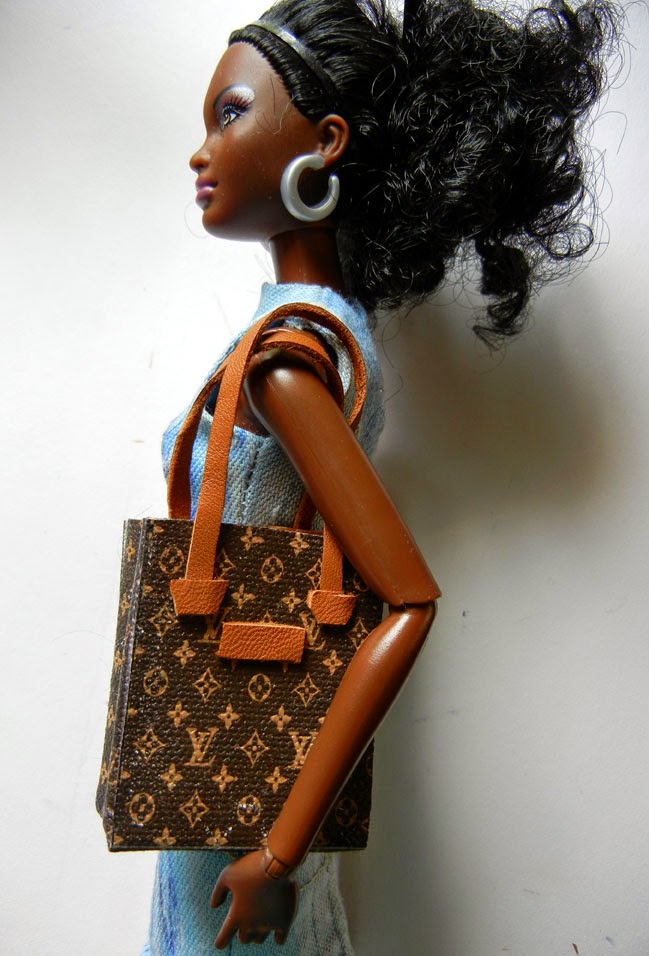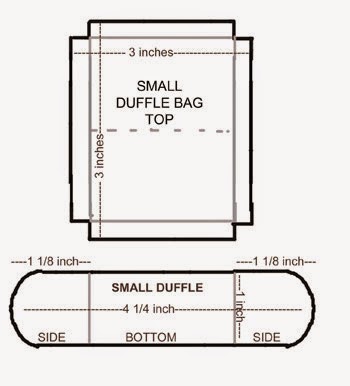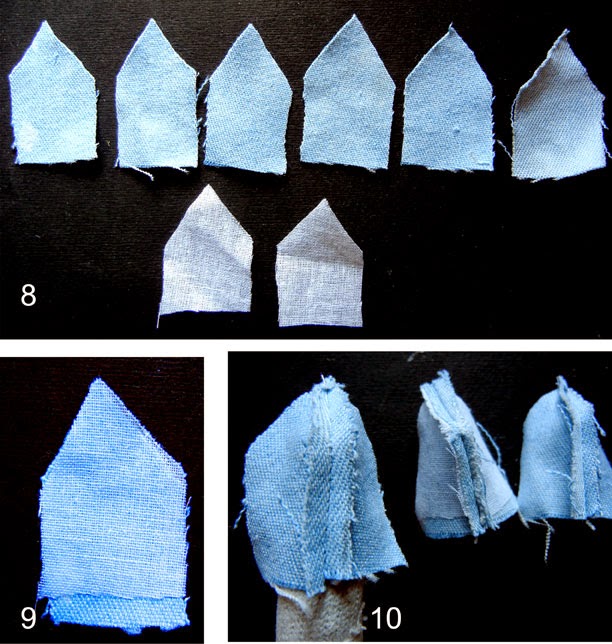I have been looking for Barbie sized luggage for quite some time now. But what I find is either a Mattel's molded (pink) plastic variety occasionally found on Ebay (cheap), Fashion Royalty's bags (expensive), or some marvelous miniatures you find on Etsy for the same price I spend on my own luggage! If you Google DIY doll luggage most bloggers use soap containers. My dolls needed something a wee bit classier! Finally, I figured it was time to make my girls some luggage they could love (and that I could afford). Quite naturally, they wanted designer luggage.
The pattern for these items is quite simple. However, the challenge is in the finishing. My items pictured here are not as perfect as I'd like them, but they are still better than a plastic soap container with wheels. Moreover, the roller bag actually opens and closes! I'm giving you the dimensions for a few very basic items, but feel free to change the dimensions. I only made one size of roller bag because it's how I travel, but maybe your girls need more luggage!
Ambitious person that I am, instead of choosing a simple fabric, I went straight for the LV baggage. And yes, I struggled. I used a sheet of (inkjet) printable canvas I emblazoned with a scaled down logo (using the technique I showed you when we did Dolly Versace prints last year). I do NOT recommend using this material for the roller bag as it was VERY hard to work with. AND, it is NOT waterproof. Nonetheless, I was so thrilled when I saw the printed canvas emerge from the printer, there was no stopping me. Next time around I will try using one of those inkjet iron-on transfer sheets over a thinner material.
THE TOTE BAG
 This is quite simple with great results. The pattern in in two pieces with the measurements as shown. My bag is 1-1/2 in wide by 2" high by 1/2" deep (39x52x13mm).
This is quite simple with great results. The pattern in in two pieces with the measurements as shown. My bag is 1-1/2 in wide by 2" high by 1/2" deep (39x52x13mm).
Cut out the tote bag along the black lines. Fold on the grey lines to shape the bag. Fold the "gusset." Glue the side and back tabs to the inside of the side/bottom piece.
Most designer luggage is a combination of canvas + leather. With the LV set, I've cut two thin strips of leather (1/8 in or 3mm) in width. I added tiny triangles at both ends then glued it onto the bag. Cut a tiny rectangle of leather to set in for the "label."
THE SMALL DUFFLE
I did not want to complicate this by trying to plan a closure. My duffle is, as they say...for display purposes. Here is my pattern. The top part is glued to the bottom and measures 3x3 inches (72x72 mm). You can scale this up should you want to make a bigger duffle bag. Again, the cutting lines are black. Fold along the grey lines. You can leave it as is or add a strip of leather to the bottom (Honestly, I made a miscalculation and used the bottom strip of leather to hide that mistake.)
Make several cuts along the curves of both ends. I added a piece of cardboard cut to the shape of the ends which add structure to this part of the bag and provide a support to glue the clipped edges to. Glue the flap over this. Add two straps cut from strips of leather (1/8 inch or 3mm).
One last thing.....don't forget the leather label!
THE ROLLER BAG
There is a reason why you don't find the roller bag in commerce. Though there are only two main pattern pieces, getting a decent result is a bit of a challenge.
The bag consists of a front, back and another side piece on which you stitch a 9 inch (22 cm) zipper. Most luggage has piping in the seams but my "designer" canvas was so stiff, I decided to keep things simple and not use it for this bag.I stitch one edge of the zipper to the long strip. I stitch the canvas very close to the zipper teeth. Attach the first rectangle (luggage side) to the other edge and hand sew. The zipper wraps around the this rectangle. Make a single stitch at the corner and then a sharp 90 degree turn. Take the second rectangle and line it up with the first one on the other side of the zipper. Again, hand stitch in place. I planned the zipper to close near the bottom of my luggage. Since I was crazy enough to use a metal zipper, I'm not so sure this was a good idea. Perhaps the side would have been better.
I cut a piece of cardboard to fit into one side of the bag. Another 1/2 inch strip goes around the perimeter. Use a bit of double sided tape to hold it in place.This adds structure to the bag.
Don't worry if the underside of your bag doesn't look so great. You will cover this part with a rectangle of fabric when you add the wheels!. But now let's work on the handles. The side handle (for carrying the bag horizontally) consists of a tiny strip of leather, two bits of wire bent into rings and two smaller bits of leather. Loop each end of the wider strip into the loops, fold over and glue. The fold over and glue the smaller strips. You will glue only the smaller strips to the side of the bag. Add metal stickers for the illusion of brass tacks.
The longer handle is a piece of bent 16 gauge wire that I poked into the back seam of the bag. I bent the ends under in the interior. I also glued a tiny piece of leather onto the handle. Next the wheels. This is a toothpick and two buttons. After you have adjusted the wheels to the width of the bag, snip off the excess and paint the rest black. Take the axel to the bottom of the bag near the back to hold in place. Then glue another piece of material over to hide the bottom and trap the wheels. Finally, the bag needs to be able to stand up on its own, so you can use a bead or create a peg using Filo clay or wood which is glued to the bottom of the piece you've just added. A detailed photo is shown with the next bag.
ROLLER BAG COUTURE
Okay, so my dolls are THRILLED to have designer luggage even with its imperfections. But the more I pondered, the more I realized the multitude of possibilities there are making dolly's own luggage. Why....she can have luggage to match her outfit like the grey wool bag here matching a dolly's Haiden Ackermann inspired pantsuit!!!
The pattern (and the steps) are exactly the same as the bag just before. I made my own piping using a strip of shiny vinyl. A string is glued to the center. Fold over and press down near where you feel the string. I basted the piping onto the zipper (folded edge near the teeth).Now stitch on the fabric rectangles catching the piping in between the zipper and the fabric. Both the zipper teeth and smooth folded edge of the piping should face inwards (on the strip).
From the wrong side it will look like this (left). While on the other side it will look like that (right). The piping will overlap a bit near the bottom. You can fix it with hand stitches to look better a bit later. Turn everything to the right side when you have finished.
Make your handle using wire and again, poke it through the top edges of the top seam near the back of the bag. Cut a piece of cardboard to fit one side of the bag and a 1/2-inch strip to place around the sides to give it structure. Bend it in place at the corners. You can use double sided take to hold it in place. Make the wheels using a toothpick and buttons as shown with the previous bag. Then cut a small rectangle of material. Fold over the edges and glue in place. On the four (wide) edges, wrap around the wheel axel and glue or hand stitch to the bottom of the bag.
Add a bead (for balance) and glue to this rectangle. You can also add pockets to the front of the bag.
Don't forget the handle on the side of the bag.
Follow us on Twitter: @FashDollStylist
We're also on Pinterest: pinterest.com/FashDollStylist
Come join in on the chatter on Tuesdays at TonnerDoll's "Dollchat" (9-10 pm Eastern Time)
All photos and images property of Fashion Doll Stylist. Please do not reproduce without prior permission. Thank you.




















































